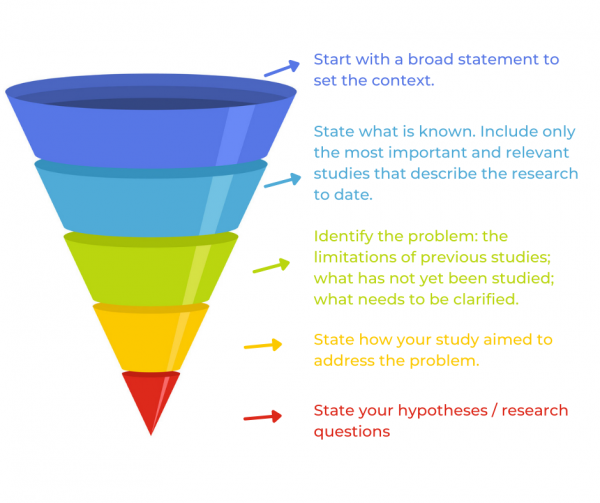




Quick Takeaways:
The English language has a rich history of borrowing words from other languages, especially from Latin. Latin abbreviations such as ‘a.m.’, ‘p.m.’ and ‘CV’ have become part of our everyday vocabulary. Such abbreviations are also frequently used in academic writing, from the ‘Ph.D.’ in the affiliation section to the ‘i.e.’, ‘e.g.’, ‘et al.’, and ‘QED’ in the rest of the paper.
This guide explains when and how to correctly use ‘et al.’ in a research paper.
在上一篇博文中,我们已经讨论过如何运用IMRAD辅助记忆法协助撰写论文摘要。我们这一篇博文将会集中在如何撰写有效的引言。
在讨论如何开始下笔前,我们要了解引言 (introduction) 在一篇论文中的目标及目的是什麽。
好的论文引言应该能让读者辨别得出你论文的研究主题、提供必不可少的内容,以及清楚表明你的研究的背后动机和焦点,而且更需要照顾到读者的兴趣和告知他们可在你的论文中读到什麽。
总括而言,你可以在开始撰写前问一下自己以下几个问题:
了解到什麽资讯你需要在引言部分提及后,可以考虑运用以下三个组织论文引言结构的基本原则。
你可以把论文引言结构想像成漏斗结构,顶部最阔的部分代表最基本的资料,然後一步步收窄到你在研究中想讨论的特定问题、研究的目的及理论等等。
下面图中列举出在论文引言漏斗不同位置需要谈及的个别资讯。
以漏斗构造概述一般的论文引言结构

最关键的一点在於要确保你的读者能够很容易跟得上你的逻辑及论证,简单点来说,就是为什麽你会选择这研究题目及研究设计。
你可以参考以下几个步骤来组织你的论文引言部分的资讯流。
第一步: 运用论文标题中的关键字在开首几句句子内让该论文所在的学科领域能被读者清楚的识别出来,以抓住他们的注意力。
但要紧记不可重复摘要的任何部分。
第二步: 以一个简短而又平衡的相关文献回顾来建立框架。
切记不要只肤浅形容过往的研究,相反,你要提供一个批判思考去定义你的研究项目的需要。
第三步: 尽可能列出你的研究目的,以及如有需要时可再举出一个或多个假设理论,来为你的研究方向提出理据。
你亦需要强调你的研究所能带出的潜在结果及贡献,以及扼要提及你论文的其馀部分。
你要时刻紧记你想在哪发表你的论文,因为这样可以助你了解你的读者。
举一个例子,如你的论文将会在一般大众期刊发表,你要确保简洁易明。相反的,如你的目标是在高度专业的期刊发表你的论文,你可能就不再需要多花篇幅解释一些你的读者已经知晓的用词及理论。
而最实用的建议就是查阅你的目标期刊的发表指引以取得相关资讯。
想要确保在论文引言中能将所有需要的资讯有效组织起来其实并不简单。明显地,你不可能在引言中包括所有资讯,这亦带出以下的问题:
作为粗略参考,引言应该大约是整篇论文的20%字数左右。但是,长度亦会因不同学科以及你计划投稿的期刊的字数要求而有所不同。
固此,时刻查阅目标期刊的发表指引以及类似论文的引言长度以作参考
如果没有引言提供的方向及背景,你的读者将会很易迷失及产生混淆,所以你要确保为他们提供需要的方向引导。
Wondering why some abbreviations such as ‘et al.’ and ‘e.g.’ use periods, whereas others such as CV and AD don’t? Periods are typically used if the abbreviations include lowercase or mixed-case letters. They’re usually not used with abbreviations containing only uppercase letters.
Our latest online workshop built on the success of face-to-face workshops we developed specifically for local universities. Over 30 faculty members joined the session, presented by our Chief Operating Officer, Mr Nick Case, to learn from our case studies on editing research proposals.
The response to our workshop, which included a constructive and insightful Q&A session, was very positive.Drawing on our extensive experience working with hundreds of Hong Kong researchers targeting the GRF and ECS every year, we used examples of poor and subsequently improved proposals to show the attendees how they can make their applications stand out. The response to our workshop, which included a constructive and insightful Q&A session, was very positive.Drawing on our extensive experience working with hundreds of Hong Kong researchers targeting the GRF and ECS every year, we used examples of poor and subsequently improved proposals to show the attendees how they can make their applications stand out. The response to our workshop, which included a constructive and insightful Q&A session, was very positive.Drawing on our extensive experience working with hundreds of Hong Kong researchers targeting the GRF and ECS every year, we used examples of poor and subsequently improved proposals to show the attendees how they can make their applications stand out.

Wondering why some abbreviations such as ‘et al.’ and ‘e.g.’ use periods, whereas others such as CV and AD don’t? Periods are typically used if the abbreviations include lowercase or mixed-case letters. They’re usually not used with abbreviations containing only uppercase letters.
Check out AsiaEdit’s professional research grant proposal editing service.
Read more about our training services covering all aspects of academic writing tailored for local institutions.
More resources on research grant proposal writing: On-demand Webinars
Preparing an effective research proposal – Your guide to successful funding application
Preparing an effective research proposal – Your guide to successful funding application (Part 2)

Rachel于2001年刚在University of Exeter 取得博士学位的同时,以自由编辑的身份首次加入我们。在担任博士后研究人员数年之后,她专注于大学教授心理学,并于2010年回到AsiaEdit,并专注于学术编辑专业。她于2018年升任助理总编辑,并于2020年继而成为我们的联合主编。由于无法完全离开学术界,她还在意大利的一所英语大学教授心理学。
你的日程安排,我们最关切 AsiaEdit采用个性化的润色方式。
香港湾仔
轩尼诗道99号2101室
9:00am – 6:00pm
(+852) 2590 6588
